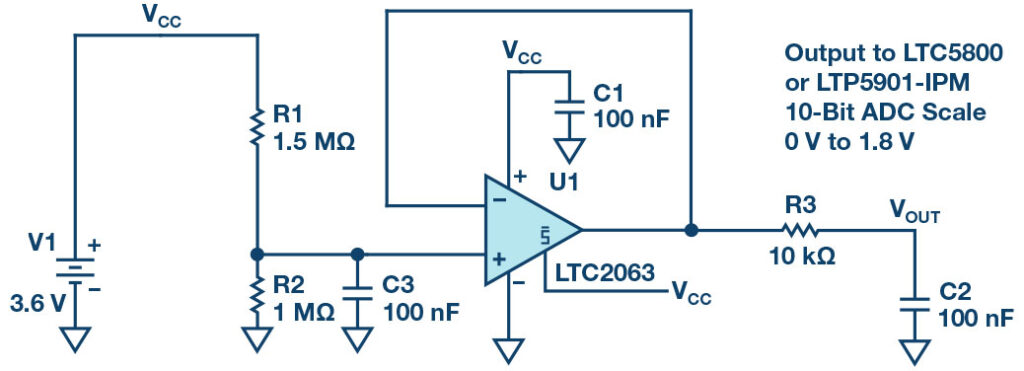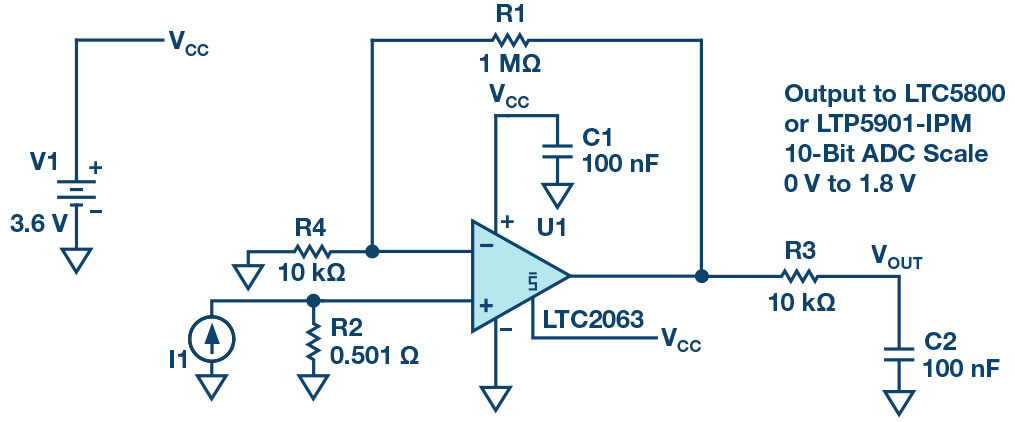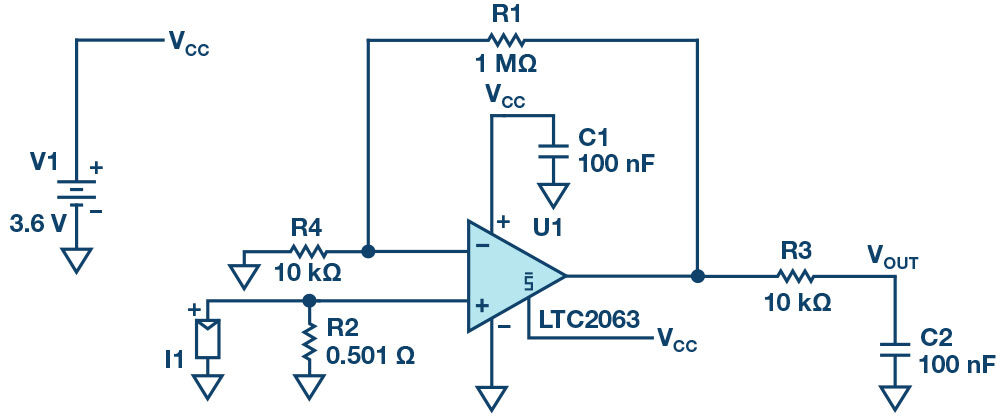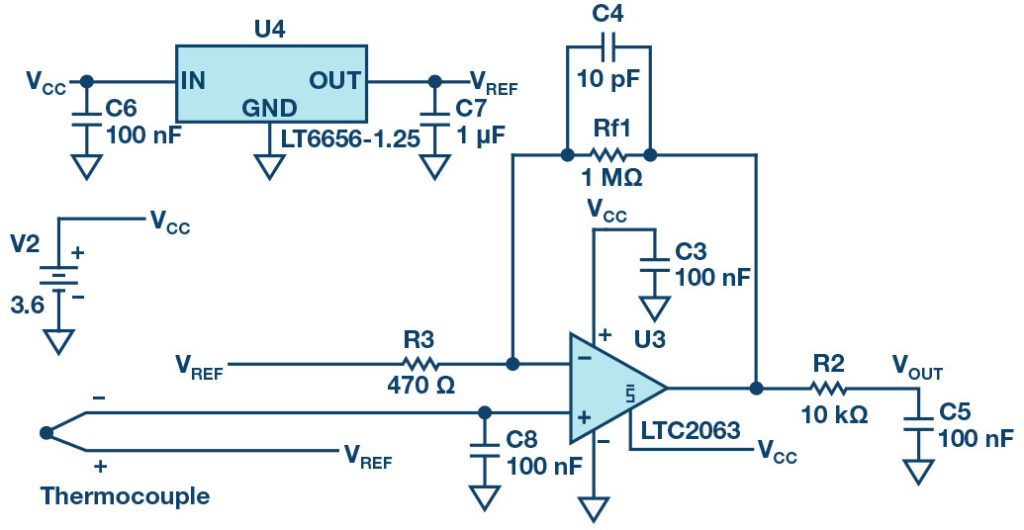The remote sensing examples shown here feature high reliability, easy connectivity, and very low power. These circuits target industrial settings that require robust communications and minimal battery maintenance. The solutions combine recent advances in low power, high precision amplification with comparably low power, high reliability wireless mesh network capability. Enabling the solutions are the LTC2063 zero-drift, low input bias amplifier, which runs at 2µA max, and the LTP5901-IPM, which consumes less than 1.5µA in sleep mode. The power dissipation for these devices is low enough that they can run from a benchtop-made battery comprised of copper and zinc electrodes, each four inches square in area, and an electrolyte consisting of the pithy innards of a lemon.
Wireless Mesh
Measurements performed and retrieved on a wireless network in industrial settings rarely require high speeds, but they usually require high reliability and security, in addition to low power operation to maximise battery operating time. The LTP5901-IPM forms a node, or a SmartMesh® IP Mote, in an 802.15.4e wireless network. The LTP5901-IPM integrates a 10-bit, 0V to 1.8V ADC alongside an internal ARM® Cortex®-M3 32-bit microprocessor, which enables sensing with easy programmability. This mote is designed for security, reliability, low power, flexibility, and programmability.
Four Sense Applications
Overall, the design of the following circuits did not require rocket science. Yet, they are tidy, efficient, and well-tailored to specific applications. Complexity is not required and, in fact, would be a cost and reliability hazard.
Each circuit engages a sensor at the input and processes the sensor output to produce an output voltage. With the LTP5901-IPM 10-bit ADC as an input, each circuit tries to map the input to capture much of the 0V to 1.8 Vrange.
Basic Battery Voltage Sense

Figure 1. Simple battery voltage sense.
Figure 1 shows a typical noninverting unity-gain negative feedback op amp configuration that senses a divided-down voltage. The ADC range on the LTP5901 input is 0V to 1.8V. R1 and R2 divide down the battery voltage with minimal quiescent current to enable long lasting battery life. The input bias current of the LTC2063 is low enough that even these large resistance values do not affect the final 10-bit ADC accuracy. The LTC2063 consumes minimal supply current and provides the advantage of zero-drift vs. time and temperature.
Current Sense

Figure 2. Current sense circuit.
The beauty of battery-powered and isolated electronics is the ability to place ground anywhere. One can sense a current in the most convenient circuit topology without loss of generality, while placing the terminals anywhere relative to local ground. For unipolar current such as a 4mA to 20mA industrial loop, one can safely sense relative to local ground using a traditional low-side topology. Figure 2 shows the current flowing through a very small resistor R2, which develops a sense voltage. This input voltage can be extremely small due to the amplifier’s zero-drift, very low valued offset voltage performance. The circuit shown gains up the input developed across a 501mΩ sense resistor by 101V/V. At 20mA, the VOUT is 1.012V. Other values can be chosen to maximise the use of the ADC’s 1.8V range.
Resistance R4 is relatively low and acts as a low impedance shunt of LTC2063 input capacitance. As a consequence, interaction between the large R1 feedback resistor and input capacitance does not play into stability.
The circuit as constructed is optimised for test current ranges from 0mA to 35mA, mapping to the 0V to 1.8V ADC range.
Irradiance Meter

Figure 3. Irradiance measurement using a solar cell in short circuit.
The circuit of Figure 2 can also be used to measure the short-circuit current of a solar cell. Silicon and other solar cells are highly linear in current vs. irradiance when operated in the short-circuit current mode. Short-circuit current is the current from a solar cell with 0V across. The circuit in Figure 3 does not keep the solar cell at precisely 0V at maximum current; however, even with 20mA in full sunlight, the voltage is only 10mV. A 10mV level across the solar cell is virtually a short on its I-V curve.
One might imagine a transimpedance amplifier (TIA) instead. A TIA can force 0V across the solar cell and measure current. The trouble with this kind of circuit is that the op amp supplies the solar cell’s current across the entire range of irradiance. When the priority is minimum power dissipation of the remote sense circuit, 20mA from the battery through the op amp is unacceptable.
Given the need to remain near 0V, a small sense resistor should be used. A remotely located, battery-powered sense of small voltages once again suggests the use of a very accurate, low power amplifier such as the LTC2063.
Solar installations result in exactly the sorts of physical layouts that demand wireless mesh networking with zero temperature drift measurement. Fortunately, silicon photodiodes, in the short-circuit condition, are fairly stable vs. temperature. A simple and robust design utilising the LTC2063 and LTP5901-IPM, combined with a silicon solar cell, is the ideal solution to sensing across a large installation field with changing ambient temperature conditions.
Temperature Measurement with Thermocouple

Figure 4. Thermocouple sense circuit.
Thermocouple voltages can be positive or negative. The circuit of Figure 4 combines the use of a micropower reference and a micropower amplifier to sense tiny voltages that are both positive and negative. It is fortunate that a thermocouple, if electrically isolated from its device under test (DUT), can be placed at whatever voltage domain is convenient. The example in Figure 4 biases the thermocouple at 1.25V by using the LT6656-1.25. The circuit output is a very highly gained version of the small thermocouple voltage on top of a 1.25V reference. The ADC range of 0V to 1.8V is a reasonable target for this configuration. The extremely high gain of roughly 2000V/V would not be feasible without the employment of a zero-drift, low offset amplifier.
Conclusion
Extremely low power, accurate, remote sensing is absolutely attainable. The examples shown in this article reveal the simplicity of combining a low power, high accuracy amplifier with a programmable system-on-chip wireless mesh node.
About the Author
Aaron Schultz is an applications engineering manager in the LPS business unit. His multiple system engineering roles in both design and applications have exposed him to topics ranging across battery management, photovoltaics, dimmable LED drive circuits, low voltage and high current dc-to-dc conversion, high speed fiber optic communication, advanced DDR3 memory R&D, custom tool development, validation, and basic analog circuits, while over half of his career has been spent in power conversion. He graduated from Carnegie Mellon University in 1993 and MIT in 1995. By night he plays jazz piano. He can be reached at aaron.schultz@analog.com.